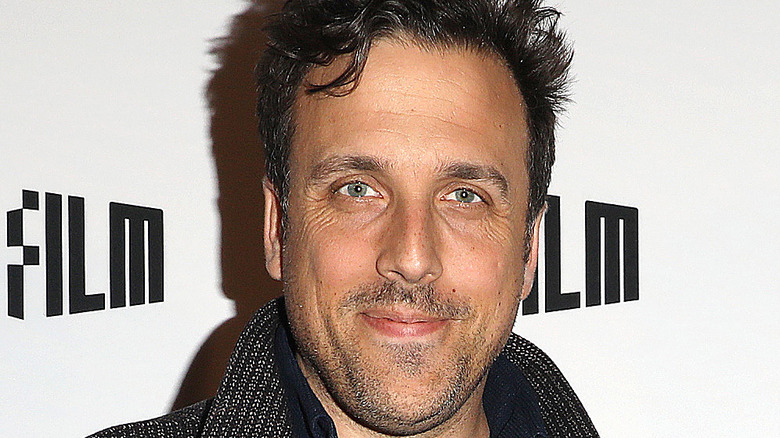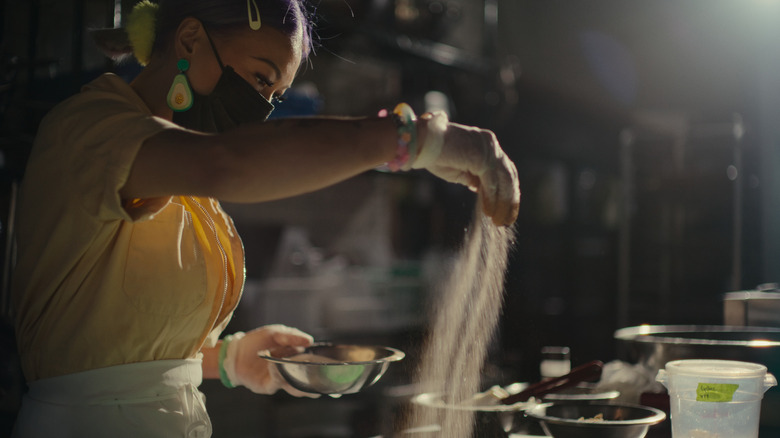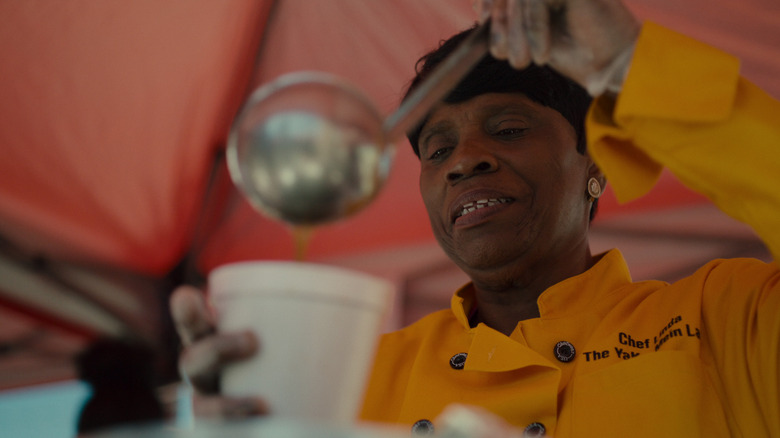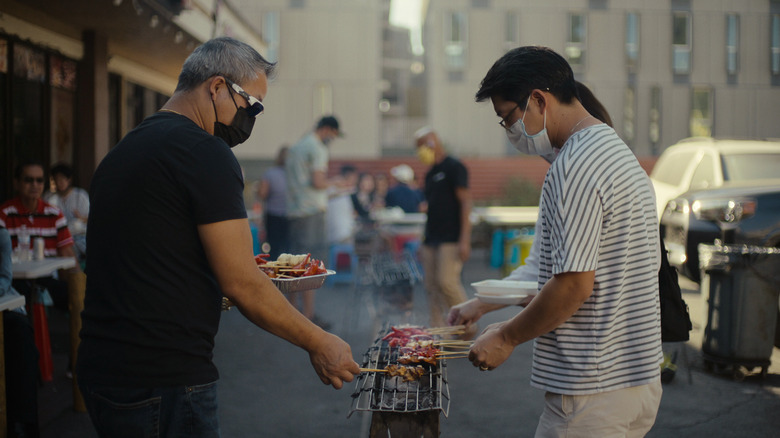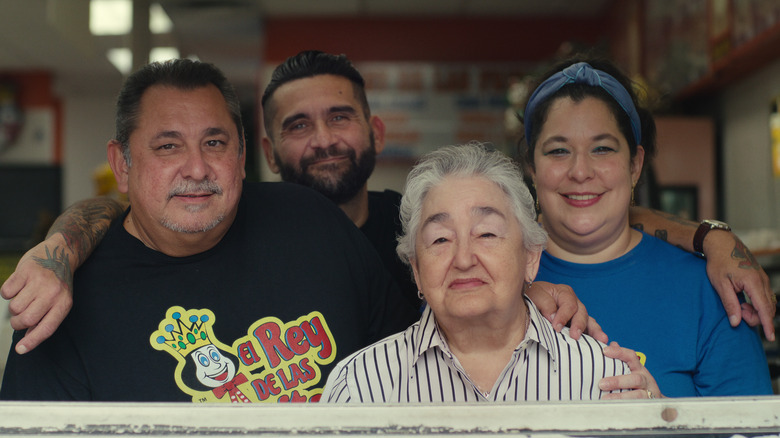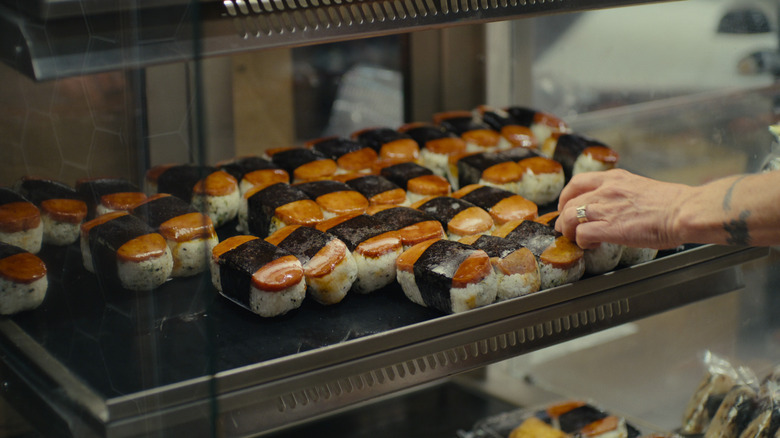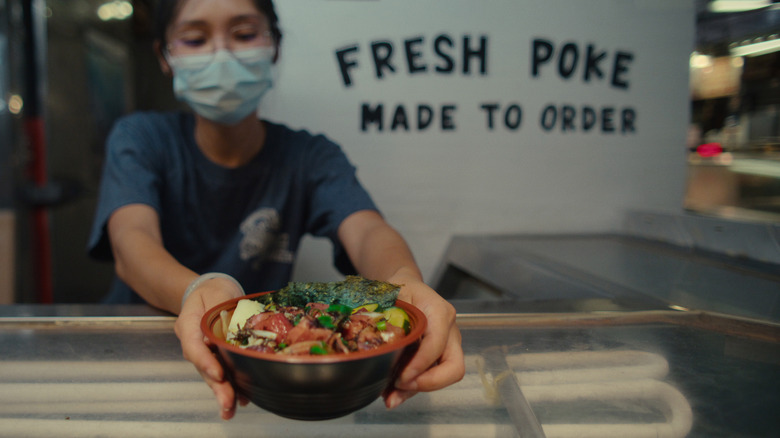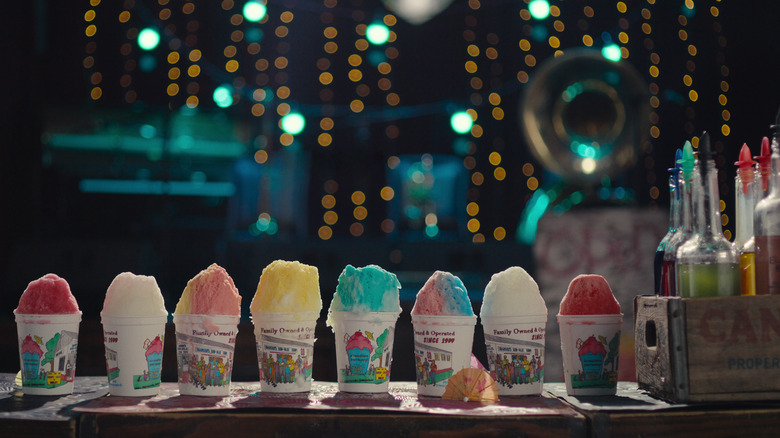Brian McGinn Tells What's Cooking On Netflix's Street Food USA And Chef's Table - Exclusive Interview
From the fine dining world of "Chef's Table" to the everyday eats of "Street Food" Brian McGinn brings it all to Netflix. The documentary film maker who acts as co-creator "Street Food" and producer of both shows has been working with Netflix since the early days of their production studio. Starting in 2015, "Chef's Table" has brought high-end chefs from around the world into the hearts and homes of viewers who may not always get a chance to taste their creations. "Street Food," which first premiered in 2019, was a natural progression, highlighting the foods of the masses from around the world.
Both shows have seen several seasons and iterations since their creation. Now back for the first time since the COVID-19 pandemic, we got the chance to sit down with Brian McGinn and talk to him about the joys and struggles of creating the shows, how the pandemic affected production, and what we can look forward to in the future.
Street Food in the USA
Can you just tell me a little bit about Street Food?
"Street Food" emerged out of the travel that we were lucky enough to do for "Chef's Table." As part of making that we've had the opportunity to go around the world and get welcomed into all these cultures, and one of the things that we noticed was everywhere that we went, we ended up loving getting introduced to the local street food.
We thought it'd be really cool to be able to tell some of these stories of people who are working with the same dedication and passion and talent as a lot of the people that we profile on "Chef's Table," but don't traditionally get the same spotlight shown on them. That was really the formation of the series, and for this season, we're excited to look around the United States and learn a little bit more about our food culture here at home by exploring the street food and take out food cultures of six cities here right in the good old US of A.
So what made you decide to do the filming here in the US this time?
Number one, we had a global pandemic that made travel difficult. Number two — I live in LA, a lot of our team lives in New York, and a few of the others are scattered around the United States. Whenever you live in a big city like this, one of the things that's so exciting about it is the diversity of food, and this amazing collision of cultures and immigrants that have all brought their styles of cooking and their food to America.
As a result, [they] created an interesting way of talking about American food, which is all of the people who have come to America bringing their own cultures, and that's something that should be celebrated in this day and age. That was exciting, for us to dive into these. Each one of these cities has an incredible story and a food culture that we could dive deep into.
What is street food?
How do you define street food?
It's really difficult. Everyone has very strong feelings on what is street food and what isn't. When we're casting the show, what we're trying to find is, in the case of this season, people who are either selling definitely from a cart on the street, which is probably the most traditional form of street food, but in New York City, the takeaway pizza slice to us felt like a street food because you grab a slice and you eat it while you're walking, or you lean against a fire hydrant outside and down a slice of pizza.
We cast a somewhat broad definition of street food, because each city also has its own definition. A lot of the street food in Miami comes from these Ventanita Cuban coffee kiosks, little cutouts, and have become meeting places for communities to come together and socialize. That's very different from LA, where we have so many taco trucks and taco carts, and that's different from Portland, where they've built these food pods.
[It's] almost a little bit like Singapore, which has its hawker culture and hawker stalls, and hawker centers where there's dozens of street food makers all in the same place. In Portland, they've built these block-long street food pods where you can go and get all sorts of different things. Honestly, the definition of street food is different in every city, so we try to learn about each city and then come up with a new definition based on what it means in that place.
What defines a good street food chef?
It's not so much what defines a good street food chef as it's what defines a good chef in general, and passion and really caring about sharing something with the world, whether that's your personal heritage, your culture's heritage, a family dish, a family recipe that's been passed down through generations, a special technique that someone has developed for making the best version of something — all of those things make people really amazing, and the hard work they put into their labor is inspiring to us.
On top of that, for our shows, we're always looking to also tell a personal story, and that story hopefully is emotional to viewers, and they come away from seeing the protagonists and the characters that we feature in our shows being presented with life's obstacles. How they respond and figure out a way to either find their voice, or to succeed, support their families, we hope that those stories end up resonating with people that are watching at home.
There's something that makes their food great, and then there's something that we look for as well, which is that personal story that will be universal and connect with more people around the world.
Documenting different cultures through food
What drew you to the idea of documenting street food?
When we were traveling around the world, we ate so much amazing street food, and that oftentimes we would go to Bangkok, or we would go to Vietnam, and local chefs, or food experts, some of the places that they would be the most excited to share with us would be their favorite street food vendors. It's the same thing in the United States; when I have friends come and visit me in LA, there are a couple places that I love to take my friends for tacos or for quesadillas, or things like that.
It was exciting to be able to dive in and learn more about the personal journeys of those people, and that was what made making the show so exciting and appealing to us.
How does street food help define different cultures?
It's different for every place. What we found in America was that the different groups that migrated to each city helped define what street food meant to each place. In cities like New York and LA, you have immigration from everywhere, so you've got incredible diversity of street food, from chicken and rice halal carts, to the taco trucks out here. We have a really large Filipino community here in Los Angeles, so Filipino skewers is one of the vendors that we featured here in LA. For those cities, there's such an incredible variety.
Then, you go down to Miami, and you have this incredible amount of Latin immigration. It's not only people coming from Cuba who have left their homeland there and settled in Miami, it's also the African American community that's really defined what street food is in Miami. In each place, we try to figure out what street food means to each city, and build from there to go around and meet as many vendors as possible.
Difficulties in making Street Food
How do you decide which vendors you're going to showcase?
It's hard. One of the things that we've learned right away, we're in LA, a few of us are in New York, we're not experts ourselves on any of these places that we're featuring. We have developed a really great network of people. We work with local journalists and local researchers in all these cities, and we start with 12-15 cities, and then we narrow it down to the six or eight that we're going to really research in depth.
We ask our local researchers, "Who should we be thinking about, who do we want to be trying, who do we want to be meeting?" We always go into it from a place of humility, saying, "What do you want to share about your city with us? What do you think people need to see?" We follow them and we go and meet all the vendors, and then it comes back to what I was talking about earlier: How amazing do we think that fruit is, and how inspiring and how much do we connect with the personal journey of the chef? It's a real collaborative process, and over a couple of months, we narrow it down.
Do you have any production difficulties that goes along with documenting these food shows?
We're really lucky. We have an amazing team of people, and we've been lucky enough to make the show with those same folks pretty much for the whole time that we've been making "Street Food." It's nothing too crazy. When we were about to film in New Orleans, it was right after they'd had a hurricane down there, and that was certainly tough because we wanted to make sure that everyone was safe, and that we weren't going to be creating any extra difficulties, but also we wanted to highlight the city in that full throated New Orleans way that we have all come to love New Orleans as.
That's an example of the kind of obstacle that we overcome, but it's nothing compared to the obstacles that the actual vendors have overcome in their day to day lives.
What's the most challenging part of producing the series?
Casting, because there's always way more folks that we would love to feature, and way more cities, honestly. When you think about it, six cities to define what street food is in America is a small amount. We didn't go down to Texas, we would love to do that. We didn't do Chicago. There's so many amazing food cities that we didn't get a chance to do because we only had six cities, and we were trying to find a nice balance between them. That's the hardest part — it's casting, and narrowing down what we're actually going to do, because there's way more things than we actually have time and resources to cover.
Surprises and joys making food shows
How does documenting street food differ from documenting the more high end foods of "Chef's Table?
I'm not sure that we approach it any differently. "Chef's Table" is a shorter show, and with "Street Food," we're also trying to showcase a city's culture as well, or in the case of some of our previous seasons, a country's culture, if you can do that in a very short period of time. That means that we spend a lot less time with each of our main characters on camera. You spend 15 minutes with one of our central characters in "Street Food," and you spend a full 40 minutes, or 45 minutes, in a "Chef's Table" episode. Making stories about people's lives changes the dynamic of how we make the show.
Other than that, "Street Food" is moving a lot faster, so we don't have as much control over a kitchen, whereas on "Chef's Table," we walk in and we go, "This is our set for the next two weeks," so making it is a little different from that standpoint too. We approach it with the same enthusiasm and passion and dedication. We want to shine a spotlight on anyone that we're taking our lives and our time to share someone else's story with the world. We're going to come into that with the same dedication and passion, no matter what the show is.
What's the most surprising thing you've learned making this series?
That's a hard question. The thing that was the most exciting for me [is ] celebrating how much diversity there is in our food culture. When you think of America, you're thinking the traditional way that we talk about hamburgers and hot dog, and this kind of stuff, but then realizing there's so much more to American food than those things that we think of as 4th of July foods. I love that we live in a culture where, under this big umbrella, we get people at the Guatemala night market making amazing food here in LA, we have people making vegan Vietnamese food in Portland.
You've got one of my favorite places, Hansen's Sno-Bliz in New Orleans, Louisiana, which makes these amazing snow cone-like things where the ice is so soft, and the syrups are so delicious. The fact that you could have all these things and an amazing slice of pizza, and all these other things, that's so cool. Every time we start researching anything, we learn so much more about food, and that makes us so excited to share it with the world. That's the thing that I love the most about the season, being able to show that American food is more than you might think on the surface.
What the future holds
Are there any plans right now for another season of "Chef's Table"?
We're hoping. We love making the show. I definitely don't think it's over, but nothing that we can dive into yet. We hope we can make all these shows, we have such a blast, and it's such a joy for us to be able to tell food stories, because food is about more than what's on the plate. It's about telling human stories and sharing the world around us with our audience, so we hope we can keep making these things forever.
Has the filming been any different for any of the shows, either "Chef's Table," which last came out before COVID-19, but also "Street Food," which is now in a continuing COVID world?
Generally, we aim to be safe when we're filming, and so everyone's wearing masks. We're doing our darnedest to keep everyone safe, and that means our vendors too. That's probably the biggest thing that's changed. Everything's a little slower as a result, but other than that, we're still lucky that we've been able to travel. For this show, we were able to travel around the states, we were able to go over to Hawaii and film there. Nothing fundamentally has changed, but in the ways that the pandemic has affected everything, there's little subtle changes.
What's it been like working with Netflix?
[We've] been so lucky. We started working with Netflix in the early days. We sold them "Chef's Table" in 2013. We started making that in 2014. We've now been working with them for eight years on "Chef's Table." I directed a feature doc[umentary] for them. We've done a number of other series for them, so we've always been really lucky to work with people that support our creative vision, and to be able to reach such a large audience.
We make international shows, we make shows in foreign languages where we're traveling all over the place, and it's so important to be able to reach the large audience that Netflix has internationally, so it's always been a pleasure.
Favorites
Of all the street food locations, do you have a favorite?
I haven't been to every single vendor in America, so I'm not really an expert there, but Hansen's Sno-Bliz is a very special place for me. I love Carnitas El Momo here in LA. They're all pretty awesome. Internationally, I had such an incredible time eating in Vietnam. In Saigon, [we featured] this woman named Truoc in the first season, whose food is amazing, and then in Oaxaca, in our second season, [we had] Doña Vale, who makes memelas in the central market. There is one of the best things you'll ever eat your entire life, so those are a couple of my favorites.
What is your go to fast food order?
I'm a California guy, so I love In-N-Out. I don't eat it very often. I'm going to be honest, I've become quite a food snob from making all these food shows.
Hazard of the trade.
Yeah, it's rough. You can play me the smallest violin in the world for that one. My go-to here in LA, I love tacos. Tacos are the best. As far as a very quick, fast food thing, I don't know if this qualifies, but there's a woodfired Peruvian roast chicken place close to me that's amazing called Pollo a la Brasa, so that's my favorite takeout, grab-it-quick kind of place.
What's one chef you would love to have cook dinner for you?
I don't think I've ever been asked that question before. I'm going to go with a chef who's no longer with us, because there's too many people living and I don't want to pick favorites, but there's an amazing Irish woman named Myrtle Allen who is the Alice Waters of Ireland, and I love her cookbook, and I cook from it a lot. I love really simple, delicious food made with good ingredients, so I'll say Myrtle Allen, but it would change minute by minute based on when you ask me.
What's one ingredient you can't live without?
Coffee and salt. Everyone under-seasons their food when they cook at home, so I'm a pretty heavy salter. When you eat a lot you become very attuned to when people don't use enough salt.
Street Food USA is streaming now on Netflix.
This interview has been edited for clarity.
